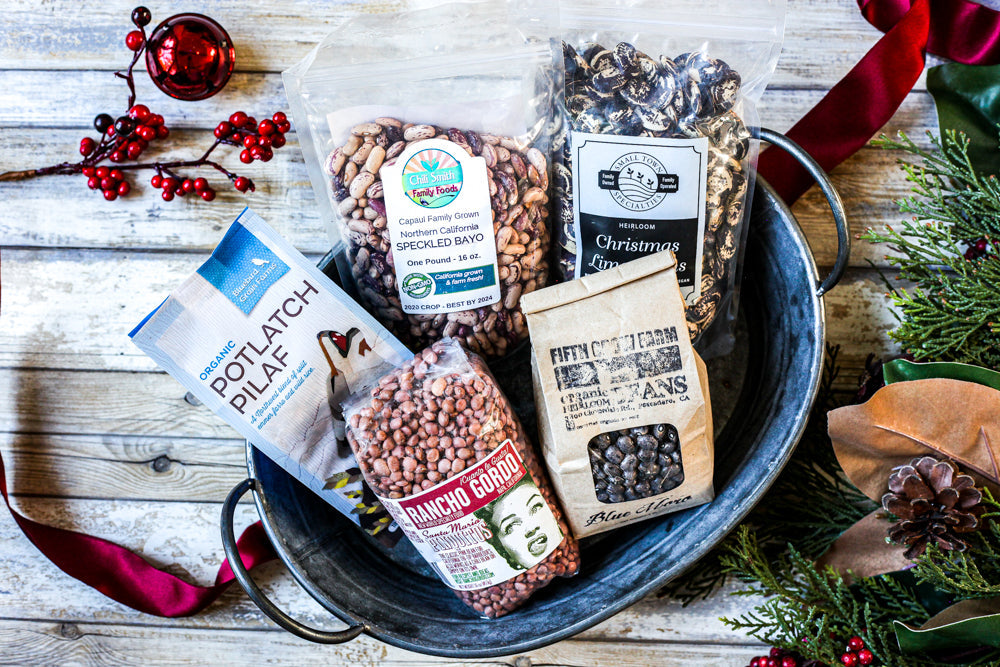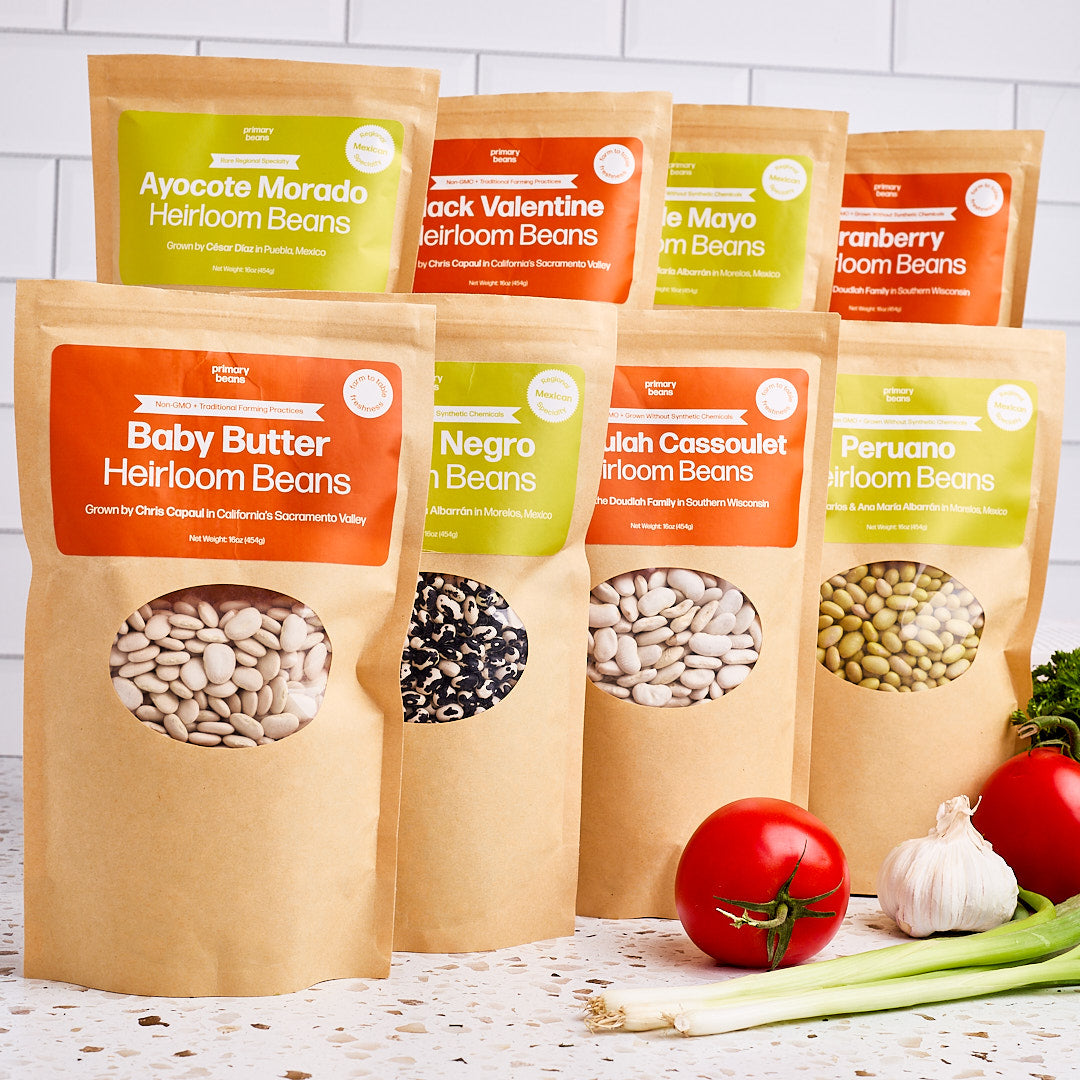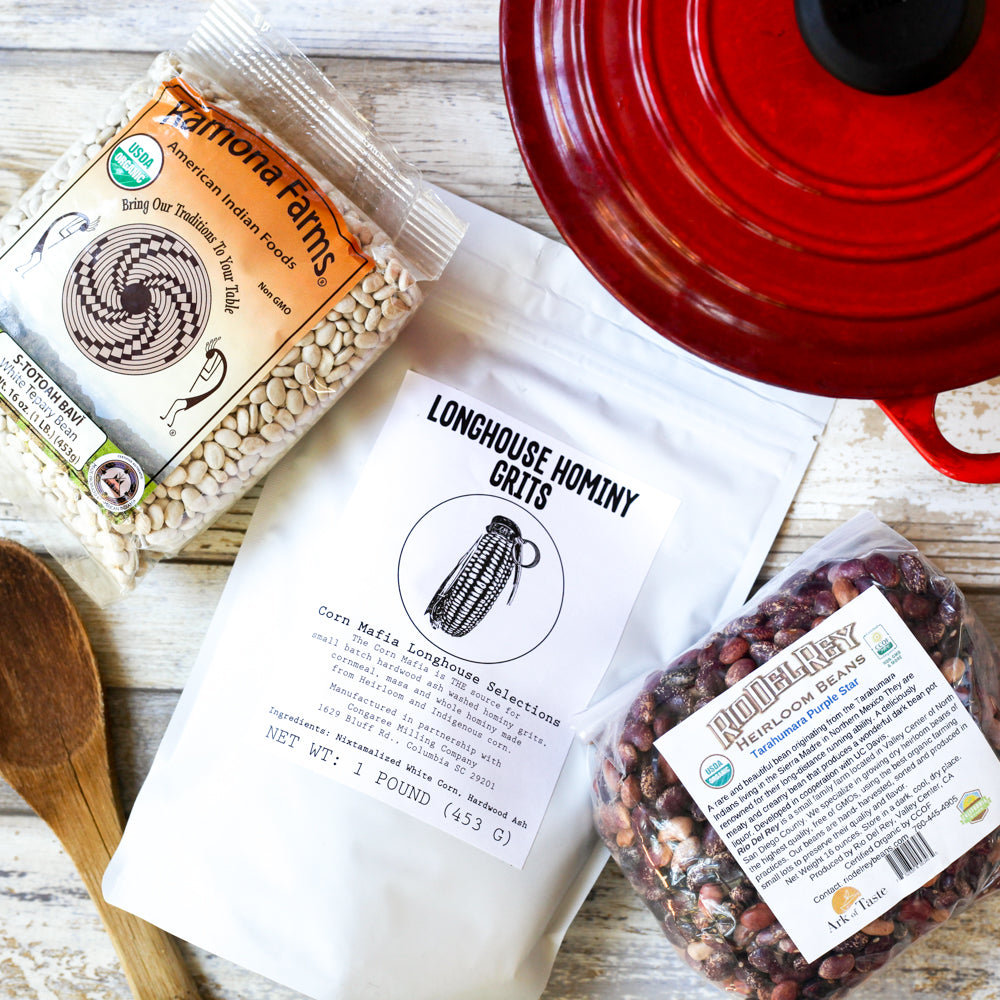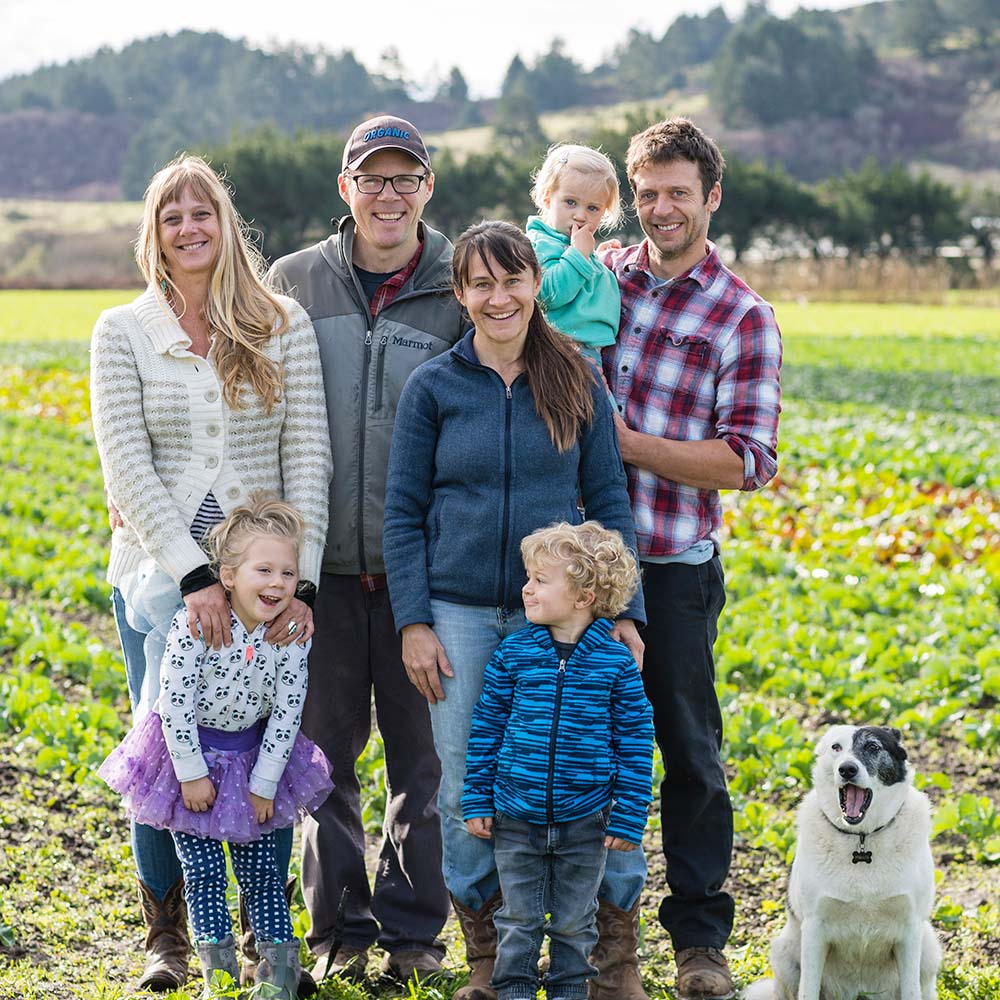10.99 FLAT RATE SHIPPING
10.99 FLAT RATE SHIPPING
SHOP

December Heirloom Bean and Grain Club
November 30, 2021 9 min read
Happy holidays! We have some new members of the club this month and we want to wish them a huge welcome. Check out the "new to the club" section below for some tips and tricks to make the most of your heirloom adventure.
We've put together a special collection for December to celebrate the season including the incredibly rare Blue Moro bean. We've added two new small farms from California and it wouldn't be the holidays without the Christmas Lima! Now get a pot of beans on the stove and sing along to favorites like "I've Bean Dreaming Of An Heirloom Christmas" "Jingle Beans" and "All I Want For Christmas Is Beans."
THE FAMILY BOX CONTAINS:
Organic Blue Moro Beans. Christmas Lima Beans, Pinquito Beans, Speckled Bayo and Organic Potlach Pilaf
REGULAR SIZE CONTAINS:
Organic Blue Moro Beans. Christmas Lima Beans, and Organic Potlach Pilaf
BEAN ONLY CONTAINS:
Organic Blue Moro Beans. Christmas Lima Beans, Cranberry Beans,
*The gluten free substitution for the potlach pilaf is Organic Brown Rice
NEW TO THE CLUB?
Even if you've been cooking beans since you were knee high to a grasshopper check out our definitive guide to cooking heirloom beans. We've spent a long time testing methods to debunk myths and prove theories. Now lets talk storage. Grains go in the refrigerator or freezer right away for the best results. Beans go in the pantry. BUT don't just look at those beans. Make a point to cook them once a week. Need inspiration? Check out our recipes below and if that's not enough check the recipe archives for more beantastic goodness.
This bean club is part of our heirloom bean and grain project. Our mission is to strengthen local food systems, promote bio-diversity, provide small, family owned farms with sustainable income and change the way we eat from plow to plate. Read more about the Heirloom Bean and Grain Project.
ORGANIC BLUE MORO BEANS
This very rare bean comes from Brazil. It's one of those beans that is so beautiful you don't know if you should cook it or put it on the table as a centerpiece. The dappled steal blue color is striking. Don't be tempted to leave them in the pantry or turn them into jewelry though because you'll be missing out on a rare treat. The moro is like a cross between a pinto and a black bean with a creamy dense texture and thin skin. The flavor is closer to a black bean with earthy undertones and a broth so velvety and delicious you'll be lapping it up. Fifth Crow Farms got their hands on the seeds for these gems from Brazil through a seed exchange and they are growing them organically.
What To Cook
Brazilian Beans is somewhat of a national dish. Different from traditional Latin bean dishes with cilantro and lime, this uses white wine vinegar and parsley, more European ingredients from the Spaniards that settled in the region. You may want to enjoy the national drink of Brazil with it, the caipirinha. Brazilian beans are very similar to the cuban favorite, Moros Y Christianos (Moors and Christians, so named after the dark beans and white rice).
Brazilian Beans

1lb of Blue Moro Beans
6 Cups of Water or vegetable or chicken stock
2-3 bay leaves
olive oil
1 yellow onion chopped
3 cloves of garlic, diced
3-4 Tablespoons of white wine vinegar (we like the chardonnay or rosé by American Vinegar Works)
1/4 Cup diced parsley
salt and pepper to taste
2 Cups Long Grain Rice (I used Carolina Gold Rice even though it's not really traditional, it's yummy)
Directions:
1. Soak the beans then cook in a large pot with water and a liberal sprinkle of salt and bayleaves until tender (about hour), or cook them from dry in a pressure cooker on high for 40 minutes. If using a pressure cooker reduce the amount of liquid. You need just enough to cover the beans with an inch to spare. This step can be done up to 3 days in advance, just refrigerate the cooked beans in their liquid until you are ready to make the rest of the recipe.
2. Begin cooking your rice. I sort of cheated and used Carolina Gold Rice because it's so darn delicious, but long grain white rice is traditional.
3. While the rice is cooking, cook the bacon (if you are using) in a pan until the fat renders and it starts to brown. Pour off all but a tablespoon of fat, add the onion and sauté until tender, add the garlic and sauté another minute, adding olive oil as needed to keep the mixture very moist.
4. Mix the onion and garlic mixture with the beans including their liquid and add the vinegar. Cook for 5-10 minutes to meld the flavors and warm the beans if they had been in the fridge. Take a 1/2 cup of the beans and liquid out and blend them in a blender then mix back into the dish to increase the thickness of the broth. Add the parsley, taste, add salt and pepper and additional vinegar if needed. Serve with rice.

About The Farmer
Fifth Crow Farms is an organic family owned farm in Pescadero, California. Grounded in a values-based approach to land stewardship, Fifth Crow Farm is a dynamic and diversified organic farm in Pescadero, CA. Founded in 2008 with a shoestring budget, a supportive local community, and ambitious dreams, they strive to bring eaters the highest quality, best tasting, and most nutritious food possible.
Fifth Crow Farm wants their farm to be more than a business: they strive to make it an engine for positive change in the food system. They are stewarding the land in a way that not only respects but improves habitat for wildlife and builds better soil for future farmers. They also believe in creating a healthy, fulfilling, and fair work environment, and providing their customers with the best tasting, most nutritious, highest quality food possible.
CHRISTMAS LIMA BEANS
The Christmas Lima is not the lima bean of your childhood nightmares. These delicious hearty beans have a distinctive nutty taste and a starchy texture similar to a baked potato. They are so hearty they work very well as a vegetarian main course but are equally good as a side or in salads. These Ark of Taste ingredients are grown on a small, family farm in Northern California just a stones through from where those famous napa grapes are grown.
The Christmas Lima Bean dates back to the 1840s, when it was especially popular in the southwestern region of the US. The bean, which is often called the Chestnut Lima because of it similarity in taste to the nut, is a large—quarter sized—white, flat seed with maroon spots and swirls. These intricate burgundy designs remain on the bean once it is cooked.
They are so large we recommend soaking them for 24 hours or using a slow cooker on low till they are tender. If you're using a pressure cooker soak for at least 12 hours and then you'll need to cook for 45 minutes to ensure they are fully cooked and don't forget the salted water! These will need more water than most beans because they are HUGE.

Christmas Lima Beans with Caramelized Onions, Mushrooms and Chard
This hearty vegan dish features the unique chestnut flavor and brilliant burgundy colors of the heirloom Christmas Lima Bean making it a perfect side or vegan main course for the holiday table. We've paired the nutty flavors of the Christmas Lima with deeply caramelized onions, thyme and the earthy flavor of mushrooms and chard. As colorful as it is tasty, even the biggest lima bean hater in the room will be asking for seconds. Get the recipe.

About The Farmer
Small Town Specialties is a family owned and operated business. Allen and Kendral are passionate about bringing you Non GMO, and Gluten-free products directly from their farm. What started with just a handful of beans, years later has turned into a flourishing crop.
SPECKLED BAYO BEANS
This is a very rare bean variety that comes from Louisiana by way of France. You'll commonly see the brown Bayo bean available which reportedly came from Mexico, but there is also evidence that European explorers discovered the "Bayo," referring to the color, while exploring Peru. As with all "common bean" varieties, this originated in the New World only to go to the Old World, it just took the long route back and picked up some interesting traits like the speckled coloring along the journey). It is related to the cranberry bean and is described as a similar to a pinto bean but more flavorful.
What To Do With Them
Other than marveling at their beautiful flecks of maroon, you can cook them as you would a pinto, they'll be a much more flavorful addition to all of your dips, soups, and sides. I think they'd make a particularly in our smoky chili mole, or this genius recipe for white chicken chili with pinto beans and poblanos.

ABOUT THE CAPAUL FAMILY
For over a century the Capaul family has been growing beans in the Sacremento Valley community of Meridian. Chris Capaul's grandfather started the farm in 1915 and beans quickly became a staple crop.
SANTA MARIA PINQUITOS
If California had a state bean, it would be the pinquito. These flavorful little pink beans come exclusively from California's Central Coast and are traditionally served with the barbecued tri-tip that made the Santa Maria region famous. They are considered the essential side dish ladled into large bowls full of bothy goodness.

There are many legends about how these diminutive legumes arrived here in the golden state. Some say Spanish cowboys brought them here, others say migrant farm workers brought them into the state. Another, somewhat official version, says that in the 50s a local farmer got his hands on some from Mexico and convinced one of the town restaurants that they'd be a good addition to the menu.
The beans are meaty in texture and they hold their shape even after hours of cooking but it's the flavor that keeps everyone coming back. Generations later they are still being prepared by that same Santa Maria restaurant and still being grown by that same family farm. You'll find dozens of recipes for Santa Maria Pinquitos online but at Jacko's they prepare them very simply with a bit of bacon, onion, garlic, salt an a little chili, simmered low and slow for 5 to 6 hours on the stove. Get the original recipe from Jacko's as printed in the Los Angeles Times HERE. Down the road a stretch in Solvang, California The Alisal Guest Ranch and Resort makes their own version of Piquitos. It's more like a West Coast answer to New England baked beans, with mustard powder and brown sugar. You'll find it here reprinted by Food & Wine Magazine. They are equally good without the pork for a vegan version of the dish and we love this recipe for vegan quinoa and pinquito tacos from Fat Free Vegan Kitchen.
ABOUT RANCHO GORDO
Rancho Gordo beans by Steve Sando are kinda a big deal. It started as a hobby of growing heirloom beans and figuring out different ways to cook them and quickly led to farmer’s markets. When the people started loving all the varieties he grew, as much as Steve did, he knew he was onto something good. Read More...
ORGANIC POTLATCH PILAF
A unique Northwest blend of Bluebird Grain's split Emmer farro and wild rice from Willamette Valley Oregon. Perfect for pilaf, wraps, stuffings, and grain salads. Emmer faro, also known as Kavilca, is one most ancient wheat varieties on the planet. It was one of the first crops domesticated in the Near East. Like einkorn and spelt wheats, emmer is hulled wheat. On threshing, a hulled wheat spike breaks up into spikelets. These require milling or pounding to release the grains from the husks. Once cultivated widely in the ancient world, it is now almost extinct in the countries where it once flourished. Here in the U.S. very few growers are cultivating this heritage grain. Lucky for us, Bluebird Grain Farms is committed to growing these ancient grains organically using regenerative farm methods for a healthier planet and a healthier us.
What To Do With It
This cooks up quickly for a delicious and hearty side. Cook according to the package directions and add the veggies and seasonings of your choice to make it your own or use their recipe for Potlatch Pilaf with Shallots and White Wine. This recipe for a Potlach Pilaf Cake with grilled tenderloin and creamed mushrooms would warm your heart on a cold winter night.
ABOUT BLUEBIRD GRAIN FARMS

Bluebird Grain Farms’ mission is to cultivate and mill the most irresistible, nutrient-rich ancient grains they can while leaving this land healthier for the next generation. Bluebird’s founding principles in soil health, nutrition, and agroecology are being expanded as they partner with like-minded “tried and true” organic grain farmers who share their founding principals of growing food for soil health and optimal nutrition.
Watch me LIVE on YouTube with Brook from Bluebird Grain Farms December 10th at 12:30pm as we cook up some holiday sides with the Potlatch Pilaf and talk a little bit about how ancient grains like these help soil health.
Recent Articles
About Us
Foodocracy is dedicated to creating a more sustainable and independent food system. We support small, independent farms across the nation.
Get impossible to find beans and grains shipped direct to your doorstep each month from small family farms.
We support small, family owned farms across the nation. Did you know that farmers only make an average of 10 cents on every dollar you spend at the supermarket? Working directly with farms and not middle men ensures that more money goes back to the people actually growning your food.
Get 10% Off
Sign up for delicious recipes and special offers.
**Regularly priced items only.



